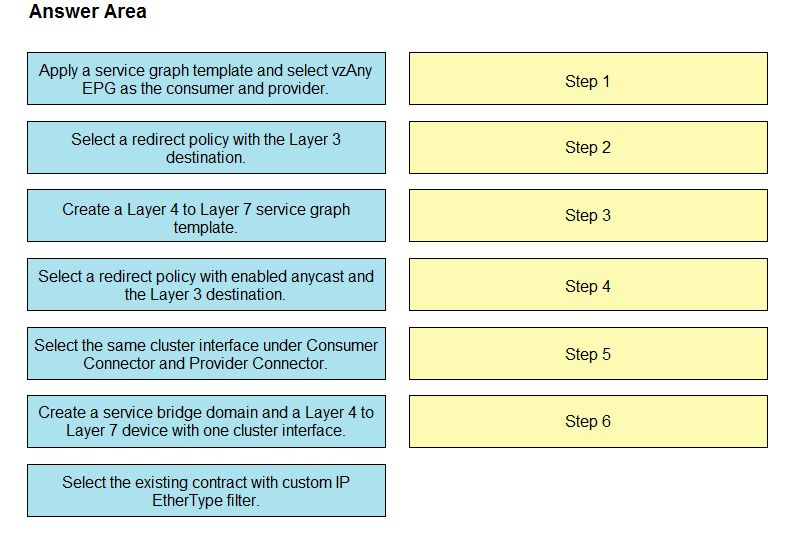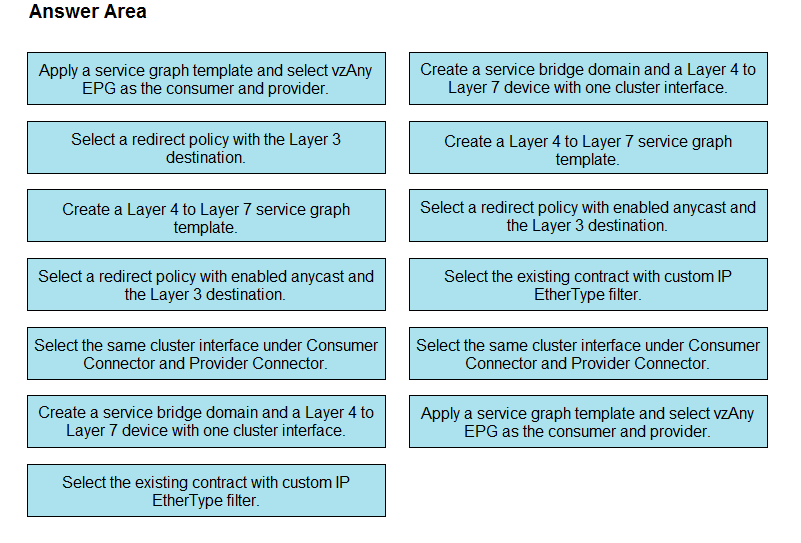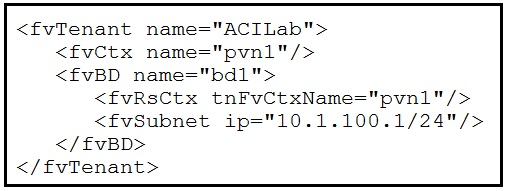Cisco® 300-620 Exam Practice Questions (P. 3)
- Full Access (346 questions)
- Six months of Premium Access
- Access to one million comments
- Seamless ChatGPT Integration
- Ability to download PDF files
- Anki Flashcard files for revision
- No Captcha & No AdSense
- Advanced Exam Configuration
Question #21
Which two types of interfaces are supported on border leaf switches to connect to an external router? (Choose two.)
- Asubinterface with VXLAN tagging
- Bsubinterface with 802.1Q tagging
- CFEX host interface
- Dout of band interface
- ESwitch Virtual Interface
Correct Answer:
BE
BE
 GPT-4o - Answer
GPT-4o - Answer
Absolutely right picks here! When connecting border leaf switches to an external router in Cisco ACI, your go-to options are typically subinterfaces with 802.1Q tagging and Switch Virtual Interfaces (SVIs). These interfaces let the switch communicate beyond the ACI fabric by allowing IP routing and VLAN tagging with external networks. Subinterfaces are perfect because they bring VLAN capabilities to a router link, a must-have for dividing traffic efficiently. On the other hand, SVIs enable routing on a switch, ensuring each VLAN can be managed individually without fuss. So, keep your focus on these interfaces when setting up connections to the outside world.
send
light_mode
delete
Question #22
Which Cisco APIC configuration prevents a remote network that is not configured on the bridge domain from being learned by the fabric?
- Aenable Limit IP Learning to SubnetMost Voted
- Benable Unicast Routing
- Cenable IP Data-plane Learning
- Denable ARP Flooding to BD
Correct Answer:
A
Reference:
https://www.cisco.com/c/en/us/solutions/collateral/data-center-virtualization/application-centric-infrastructure/white-paper-c11-739989.html
A
Reference:
https://www.cisco.com/c/en/us/solutions/collateral/data-center-virtualization/application-centric-infrastructure/white-paper-c11-739989.html
send
light_mode
delete
Question #23
An engineer needs to deploy a leaf access port policy group in ACI Fabric to support the following requirements:
✑ Control the amount of application data flowing into the system
✑ Allow the newly connected device to auto-negotiate link speed with the leaf switch
Which two ACI policies must be configured to achieve these requirements? (Choose two.)
✑ Control the amount of application data flowing into the system
✑ Allow the newly connected device to auto-negotiate link speed with the leaf switch
Which two ACI policies must be configured to achieve these requirements? (Choose two.)
- Alink level policyMost Voted
- BL2 interface policy
- Cslow drain policy
- Dingress data plane policing policyMost Voted
- Eingress control plane policing policy
Correct Answer:
AD
Reference:
https://www.cisco.com/c/en/us/td/docs/switches/datacenter/aci/apic/sw/kb/b_Cisco_ACI_and_Forward_Error_Correction.html https://www.cisco.com/c/en/us/td/docs/switches/datacenter/aci/apic/sw/4-x/security/Cisco-APIC-Security-Configuration-Guide-401/ b_Cisco_APIC_Security_Guide_chapter_01110.html#:~:text=Use%20data%20plane%20policing%20(DPP,dropping%20of%20packets%20occurs%
20immediately
.
AD
Reference:
https://www.cisco.com/c/en/us/td/docs/switches/datacenter/aci/apic/sw/kb/b_Cisco_ACI_and_Forward_Error_Correction.html https://www.cisco.com/c/en/us/td/docs/switches/datacenter/aci/apic/sw/4-x/security/Cisco-APIC-Security-Configuration-Guide-401/ b_Cisco_APIC_Security_Guide_chapter_01110.html#:~:text=Use%20data%20plane%20policing%20(DPP,dropping%20of%20packets%20occurs%
20immediately
.
send
light_mode
delete
Question #24
A customer migrates a legacy environment to Cisco ACI. A Layer 2 trunk is configured to interconnect the two environments. The customer also builds ACI fabric in an application-centric mode. Which feature should be enabled in the bridge domain to reduce instability during the migration?
- ASet Multi-Destination Flooding to Flood in BD.
- BEnable Flood in Encapsulation.
- CSet Multi-Destination Flooding to Flood in Encapsulation.Most Voted
- DDisable Endpoint Dataplane Learning
Correct Answer:
C
?️
 GPT-4o - Answer
GPT-4o - Answer
When migrating a legacy environment to Cisco ACI, and particularly while setting up the ACI in application-centric mode, consider how multiple EPGs correlate within a single bridge domain (BD), often under differing VLAN tags. During the migration, it's beneficial to set Multi-Destination Flooding to "Flood in BD." This configuration allows for consistent flooding across the entire BD, ensuring that multicast, broadcast, and unknown unicast traffic is uniformly handled across multiple EPGs even with separate VLAN tags. This minimizes potential instability by maintaining traffic continuity between the ACI fabric and legacy systems.
send
light_mode
delete
Question #25
New ESXi hosts are procured in a data center compute expansion project. An engineer must update the configuration on the Cisco APIC controllers to support the addition of the new servers to the existing VMM domain. Which action should be taken to support this change?
- ACreate a range of internal VLANs in the associated VLAN pool.
- BSet the encapsulation mode as VXLAN.
- CEnable infrastructure VLAN in the associated AEP.
- DMap the leaf interface selector to the AEP that is associated with the VMM domain.Most Voted
Correct Answer:
D
D
 GPT-4o - Answer
GPT-4o - Answer
The correct action involves mapping the leaf interface selector to the Associated Application Entity Policy (AEP) linked with the VMM domain. This setup ensures that the newly added ESXi hosts are recognized under the correct virtual machine management domain, allowing streamlined management and connectivity within the Cisco ACI environment. This direct binding is essential in extending the domain's capabilities to accommodate additional hosts effectively.
send
light_mode
delete
Question #26
DRAG DROP -

Refer to the exhibit. A Cisco ACI fabric is newly deployed, and the security team requires more visibility of all inter EPG traffic flows. All traffic in a VRF must be forwarded to an existing firewall pair. During failover, the standby firewall must continue to use the same IP and MAC as the primary firewall. Drag and drop the steps from the left into the implementation order on the right to configure the service graph that meets the requirements. (Not all steps are used.)
Select and Place:


Refer to the exhibit. A Cisco ACI fabric is newly deployed, and the security team requires more visibility of all inter EPG traffic flows. All traffic in a VRF must be forwarded to an existing firewall pair. During failover, the standby firewall must continue to use the same IP and MAC as the primary firewall. Drag and drop the steps from the left into the implementation order on the right to configure the service graph that meets the requirements. (Not all steps are used.)
Select and Place:

Correct Answer:

Reference:
https://www.cisco.com/c/en/us/td/docs/switches/datacenter/aci/apic/sw/3-x/L4-L7_services_deployment/3_2_1/b_L4L7_Deploy_321/ b_L4L7_Deploy_321_chapter_01001.html

Reference:
https://www.cisco.com/c/en/us/td/docs/switches/datacenter/aci/apic/sw/3-x/L4-L7_services_deployment/3_2_1/b_L4L7_Deploy_321/ b_L4L7_Deploy_321_chapter_01001.html
send
light_mode
delete
Question #27
An engineer is extending an EPG out of the ACI fabric using static path binding. Which statement about the endpoints is true?
- AEndpoints must connect directly to the ACI leaf port.
- BExternal endpoints are in a different bridge domain than the endpoints in the fabric.
- CEndpoint learning encompasses the MAC address only.
- DExternal endpoints are in the same EPG as the directly attached endpoints.Most Voted
Correct Answer:
D
?️
 GPT-4o - Answer
GPT-4o - Answer
When extending an EPG outside of the ACI fabric using static path binding, the primary concern is how endpoints are identified and managed. For ACI, endpoint learning within this context focuses predominantly on the MAC addresses. The system logs the MAC address of devices communicating through the statically bound ports. This aspect of endpoint learning is crucial as it maintains the integrity and efficiency of network operations, ensuring that traffic management and access control policies continue to apply correctly even as the network extends beyond the immediate ACI fabric. Although extending the EPG to include external endpoints under the same policies seems viable, the understanding of endpoint learning based solely on MAC addresses is pivotal.
send
light_mode
delete
Question #28
Which setting prevents the learning of Endpoint IP addresses whose subnet does not match the bridge domain subnet?
- A"Limit IP learning to network" setting within the bridge domain.
- B"Limit IP learning to subnet" setting within the EPG.
- C"Limit IP learning to network" setting within the EPG.
- D"Limit IP learning to subnet" setting within the bridge domain.Most Voted
Correct Answer:
D
Reference:
https://www.cisco.com/c/en/us/td/docs/switches/datacenter/aci/apic/sw/2-x/L2_config/b_Cisco_APIC_Layer_2_Configuration_Guide/ b_Cisco_APIC_Layer_2_Configuration_Guide_chapter_010.html
D
Reference:
https://www.cisco.com/c/en/us/td/docs/switches/datacenter/aci/apic/sw/2-x/L2_config/b_Cisco_APIC_Layer_2_Configuration_Guide/ b_Cisco_APIC_Layer_2_Configuration_Guide_chapter_010.html
send
light_mode
delete
Question #29
Which endpoint learning operation is completed on the egress leaf switch when traffic is received from an L3Out?
- AThe source MAC and IP address of the traffic is learned as a local endpoint.
- BThe source MAC address of the traffic is learned as a remote endpoint.
- CNo source MAC or IP address of the traffic is learned as a remote endpoint.Most Voted
- DThe source IP address of the traffic is learned as a remote endpoint.
send
light_mode
delete
Question #30

Refer to the exhibit. Which two objects are created as a result of the configuration? (Choose two.)
- Aapplication profile
- Battachable AEP
- Cbridge domain
- Dendpoint group
- EVRF
Correct Answer:
CE
Reference:
https://www.cisco.com/c/en/us/td/docs/switches/datacenter/aci/apic/sw/2-x/rest_cfg/2_1_x/b_Cisco_APIC_REST_API_Configuration_Guide/ b_Cisco_APIC_REST_API_Configuration_Guide_chapter_01110.html
CE
Reference:
https://www.cisco.com/c/en/us/td/docs/switches/datacenter/aci/apic/sw/2-x/rest_cfg/2_1_x/b_Cisco_APIC_REST_API_Configuration_Guide/ b_Cisco_APIC_REST_API_Configuration_Guide_chapter_01110.html
send
light_mode
delete
All Pages
